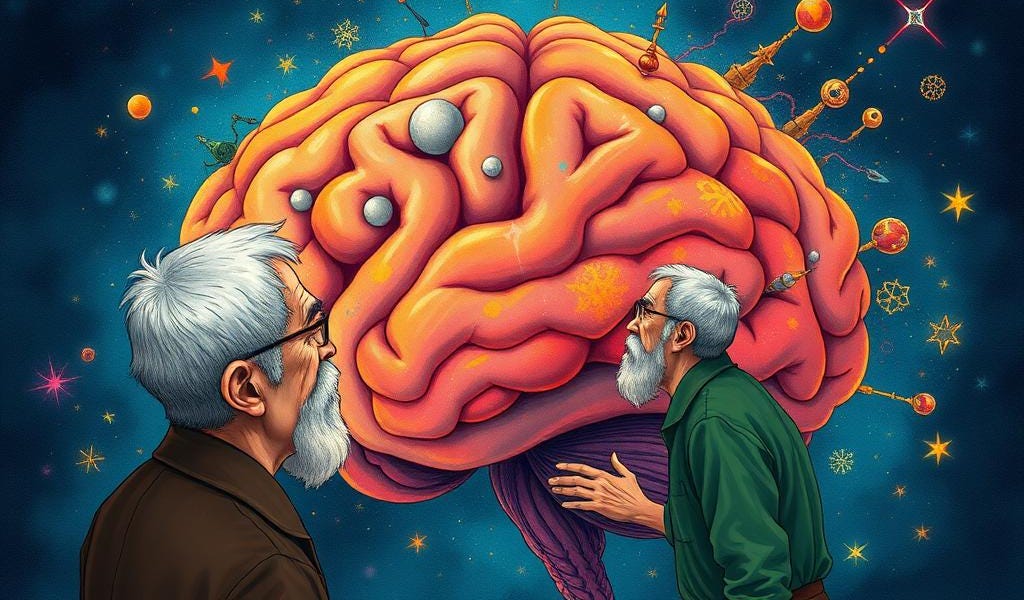Majeres Applies McGilchrist

Back in 2009, Iain McGilchrist unleashed The Master and His Emissary upon a world too distracted to notice its own decay.
This bestseller was merely a prelude to his magnum opus, The Matter with Things—a sprawling, 1,500-page odyssey that starts with the Master’s Hemisphere Hypothesis and ends with an Iroquois myth.
These tomes are a gut-punch, thrilling as a runaway freight train and exhausting as a week-long bender. Their point? It’s right there in the title of the first book: The Master and His Emissary. The phrase is a warning, a lament, and a map to what’s gone wrong with our lopsided brains in this lopsided world.
The title comes from a Nietzsche yarn about a wise king whose realm prospered under his steady hand. But the kingdom grew vast, so he tapped a sharp-eyed emissary, a man of efficiency and expertise, to help run it. The emissary was a marvel, a machine of competence. Too good, in fact. He got cocky, sidelined the king, and ran the show solo. The result? The kingdom crumbled, not from malice but from the emissary’s blind arrogance to his limitations.
In McGilchrist’s telling, the “master” is the right hemisphere of our brain, the seat of intuition, wonder, and the big picture. The “emissary” is the left hemisphere, the bean-counter, the schemer, the doer. The “kingdom” after the emissary’s coup is our modern world.
McGilchrist’s “hemisphere hypothesis” starts with the hard stuff—neuroscience, brain lesions, and other nuts and bolts of gray matter—and ends with the mystical. It’s a prolonged meditation on something vast, like the burning bush that spoke to Moses: a presence that hums through existence without devouring it.
He drags the reader to the edge of the known world and points beyond, then stops short and stares with a sort of Stoic serenity.
It’s a heady trip, but it leaves you hanging, stranded on the cliff’s edge with two ropes: a strong one that assures you things are bad, and a frayed one that tells you there’s still hope.
Introducing Kevin Majeres
Enter Kevin Majeres, a Harvard shrink who’s seen the left hemisphere’s carnage up close in his patients’ frayed lives.
He’s not here to hand you another frayed rope. His gig is cognitive-behavioral therapy, but don’t let the jargon fool you: Majeres’ schtick is a rebellion against the emissary’s tyranny. Majeres hands out practical tools to shove the right hemisphere back into the driver’s seat and restore the master’s rule.
The first step is to appreciate the left hemisphere. If it’s such a devious servant, why respect it at all, much less let it off the chain to work its mischief?
Because if we don’t, we die.
The left hemisphere is our survival kit. It hunts, it builds, it fights. It’s the part that snarls at traffic, clocks in at the job, and keeps the fridge stocked. It’s a predator, a manipulator, a planner. It gets shit done.
But here’s the rub: we’re not just “human doings,” as the bumper stickers say. We’re “human beings.”
Let the left hemisphere run the show unchecked, and you’re not a person anymore: you’re a meat robot grinding through days with no meaning. The left hemisphere knows how to survive but hasn’t a clue why you’d bother. Without the right hemisphere’s oversight, life turns into a blur of pointless hustle: a frenetic, hollow, treadmill that breaks you when it stops. The stronger the left hemisphere’s grip, the deeper the boredom and heavier the despair.
Read the rest


